这篇文章主要讲解了“Javascript常见数据结构的实现方法是什么”,文中的讲解内容简单清晰,易于学习与理解,下面请大家跟着小编的思路慢慢深入,一起来研究和学习“Javascript常见数据结构的实现方法是什么”吧!
1. Stack(栈)
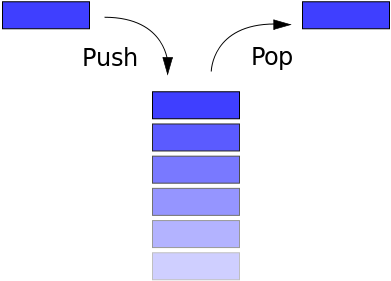
Stack的特点是后进先出(last in first out)。生活中常见的Stack的例子比如一摞书,你最后放上去的那本你之后会最先拿走;又比如浏览器的访问历史,当点击返回按钮,最后访问的网站最先从历史记录中弹出。
Stack一般具备以下方法:
push:将一个元素推入栈顶
pop:移除栈顶元素,并返回被移除的元素
peek:返回栈顶元素
length:返回栈中元素的个数
Javascript的Array天生具备了Stack的特性,但我们也可以从头实现一个 Stack类:
function Stack() { this.count = 0; this.storage = {}; this.push = function (value) { this.storage[this.count] = value; this.count++; } this.pop = function () { if (this.count === 0) { return undefined; } this.count--; var result = this.storage[this.count]; delete this.storage[this.count]; return result; } this.peek = function () { return this.storage[this.count - 1]; } this.size = function () { return this.count; } }2. Queue(队列)

Queue和Stack有一些类似,不同的是Stack是先进后出,而Queue是先进先出。Queue在生活中的例子比如排队上公交,排在第一个的总是最先上车;又比如打印机的打印队列,排在前面的最先打印。
Queue一般具有以下常见方法:
enqueue:入列,向队列尾部增加一个元素
dequeue:出列,移除队列头部的一个元素并返回被移除的元素
front:获取队列的第一个元素
isEmpty:判断队列是否为空
size:获取队列中元素的个数
Javascript中的Array已经具备了Queue的一些特性,所以我们可以借助Array实现一个Queue类型:
function Queue() { var collection = []; this.print = function () { console.log(collection); } this.enqueue = function (element) { collection.push(element); } this.dequeue = function () { return collection.shift(); } this.front = function () { return collection[0]; } this.isEmpty = function () { return collection.length === 0; } this.size = function () { return collection.length; } }Priority Queue(优先队列)
Queue还有个升级版本,给每个元素赋予优先级,优先级高的元素入列时将排到低优先级元素之前。区别主要是enqueue方法的实现:
function PriorityQueue() { ... this.enqueue = function (element) { if (this.isEmpty()) { collection.push(element); } else { var added = false; for (var i = 0; i < collection.length; i++) { if (element[1] < collection[i][1]) { collection.splice(i, 0, element); added = true; break; } } if (!added) { collection.push(element); } } } }测试一下:
var pQ = new PriorityQueue(); pQ.enqueue(['gannicus', 3]); pQ.enqueue(['spartacus', 1]); pQ.enqueue(['crixus', 2]); pQ.enqueue(['oenomaus', 4]); pQ.print();
结果:
[ [ 'spartacus', 1 ], [ 'crixus', 2 ], [ 'gannicus', 3 ], [ 'oenomaus', 4 ] ]
3. Linked List(链表)

顾名思义,链表是一种链式数据结构,链上的每个节点包含两种信息:节点本身的数据和指向下一个节点的指针。链表和传统的数组都是线性的数据结构,存储的都是一个序列的数据,但也有很多区别,如下表:

一个单向链表通常具有以下方法:
size:返回链表中节点的个数
head:返回链表中的头部元素
add:向链表尾部增加一个节点
remove:删除某个节点
indexOf:返回某个节点的index
elementAt:返回某个index处的节点
addAt:在某个index处插入一个节点
removeAt:删除某个index处的节点
单向链表的Javascript实现:
/** * 链表中的节点 */ function Node(element) { // 节点中的数据 this.element = element; // 指向下一个节点的指针 this.next = null; } function LinkedList() { var length = 0; var head = null; this.size = function () { return length; } this.head = function () { return head; } this.add = function (element) { var node = new Node(element); if (head == null) { head = node; } else { var currentNode = head; while (currentNode.next) { currentNode = currentNode.next; } currentNode.next = node; } length++; } this.remove = function (element) { var currentNode = head; var previousNode; if (currentNode.element === element) { head = currentNode.next; } else { while (currentNode.element !== element) { previousNode = currentNode; currentNode = currentNode.next; } previousNode.next = currentNode.next; } length--; } this.isEmpty = function () { return length === 0; } this.indexOf = function (element) { var currentNode = head; var index = -1; while (currentNode) { index++; if (currentNode.element === element) { return index; } currentNode = currentNode.next; } return -1; } this.elementAt = function (index) { var currentNode = head; var count = 0; while (count < index) { count++; currentNode = currentNode.next; } return currentNode.element; } this.addAt = function (index, element) { var node = new Node(element); var currentNode = head; var previousNode; var currentIndex = 0; if (index > length) { return false; } if (index === 0) { node.next = currentNode; head = node; } else { while (currentIndex < index) { currentIndex++; previousNode = currentNode; currentNode = currentNode.next; } node.next = currentNode; previousNode.next = node; } length++; } this.removeAt = function (index) { var currentNode = head; var previousNode; var currentIndex = 0; if (index < 0 || index >= length) { return null; } if (index === 0) { head = currentIndex.next; } else { while (currentIndex < index) { currentIndex++; previousNode = currentNode; currentNode = currentNode.next; } previousNode.next = currentNode.next; } length--; return currentNode.element; } }4. Set(集合)
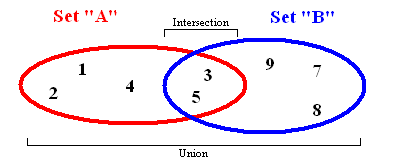
集合是数学中的一个基本概念,表示具有某种特性的对象汇总成的集体。在ES6中也引入了集合类型Set,Set和Array有一定程度的相似,不同的是Set中不允许出现重复的元素而且是无序的。
一个典型的Set应该具有以下方法:
values:返回集合中的所有元素
size:返回集合中元素的个数
has:判断集合中是否存在某个元素
add:向集合中添加元素
remove:从集合中移除某个元素
union:返回两个集合的并集
intersection:返回两个集合的交集
difference:返回两个集合的差集
subset:判断一个集合是否为另一个集合的子集
使用Javascript可以将Set进行如下实现,为了区别于ES6中的Set命名为MySet:
function MySet() { var collection = []; this.has = function (element) { return (collection.indexOf(element) !== -1); } this.values = function () { return collection; } this.size = function () { return collection.length; } this.add = function (element) { if (!this.has(element)) { collection.push(element); return true; } return false; } this.remove = function (element) { if (this.has(element)) { index = collection.indexOf(element); collection.splice(index, 1); return true; } return false; } this.union = function (otherSet) { var unionSet = new MySet(); var firstSet = this.values(); var secondSet = otherSet.values(); firstSet.forEach(function (e) { unionSet.add(e); }); secondSet.forEach(function (e) { unionSet.add(e); }); return unionSet; } this.intersection = function (otherSet) { var intersectionSet = new MySet(); var firstSet = this.values(); firstSet.forEach(function (e) { if (otherSet.has(e)) { intersectionSet.add(e); } }); return intersectionSet; } this.difference = function (otherSet) { var differenceSet = new MySet(); var firstSet = this.values(); firstSet.forEach(function (e) { if (!otherSet.has(e)) { differenceSet.add(e); } }); return differenceSet; } this.subset = function (otherSet) { var firstSet = this.values(); return firstSet.every(function (value) { return otherSet.has(value); }); } }5. Hash Table(哈希表/散列表)

Hash Table是一种用于存储键值对(key value pair)的数据结构,因为Hash Table根据key查询value的速度很快,所以它常用于实现Map、Dictinary、Object等数据结构。如上图所示,Hash Table内部使用一个hash函数将传入的键转换成一串数字,而这串数字将作为键值对实际的key,通过这个key查询对应的value非常快,时间复杂度将达到O(1)。Hash函数要求相同输入对应的输出必须相等,而不同输入对应的输出必须不等,相当于对每对数据打上唯一的指纹。
一个Hash Table通常具有下列方法:
add:增加一组键值对
remove:删除一组键值对
lookup:查找一个键对应的值
一个简易版本的Hash Table的Javascript实现:
function hash(string, max) { var hash = 0; for (var i = 0; i < string.length; i++) { hash += string.charCodeAt(i); } return hash % max; } function HashTable() { let storage = []; const storageLimit = 4; this.add = function (key, value) { var index = hash(key, storageLimit); if (storage[index] === undefined) { storage[index] = [ [key, value] ]; } else { var inserted = false; for (var i = 0; i < storage[index].length; i++) { if (storage[index][i][0] === key) { storage[index][i][1] = value; inserted = true; } } if (inserted === false) { storage[index].push([key, value]); } } } this.remove = function (key) { var index = hash(key, storageLimit); if (storage[index].length === 1 && storage[index][0][0] === key) { delete storage[index]; } else { for (var i = 0; i < storage[index]; i++) { if (storage[index][i][0] === key) { delete storage[index][i]; } } } } this.lookup = function (key) { var index = hash(key, storageLimit); if (storage[index] === undefined) { return undefined; } else { for (var i = 0; i < storage[index].length; i++) { if (storage[index][i][0] === key) { return storage[index][i][1]; } } } } }6. Tree(树)

顾名思义,Tree的数据结构和自然界中的树极其相似,有根、树枝、叶子,如上图所示。Tree是一种多层数据结构,与Array、Stack、Queue相比是一种非线性的数据结构,在进行插入和搜索操作时很高效。在描述一个Tree时经常会用到下列概念:
Root(根):代表树的根节点,根节点没有父节点
Parent Node(父节点):一个节点的直接上级节点,只有一个
Child Node(子节点):一个节点的直接下级节点,可能有多个
Siblings(兄弟节点):具有相同父节点的节点
Leaf(叶节点):没有子节点的节点
Edge(边):两个节点之间的连接线
Path(路径):从源节点到目标节点的连续边
Height of Node(节点的高度):表示节点与叶节点之间的最长路径上边的个数
Height of Tree(树的高度):即根节点的高度
Depth of Node(节点的深度):表示从根节点到该节点的边的个数
Degree of Node(节点的度):表示子节点的个数
我们以二叉查找树为例,展示树在Javascript中的实现。在二叉查找树中,即每个节点最多只有两个子节点,而左侧子节点小于当前节点,而右侧子节点大于当前节点,如图所示:
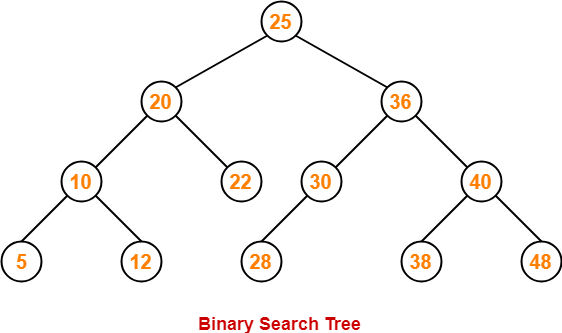
一个二叉查找树应该具有以下常用方法:
add:向树中插入一个节点
findMin:查找树中最小的节点
findMax:查找树中最大的节点
find:查找树中的某个节点
isPresent:判断某个节点在树中是否存在
remove:移除树中的某个节点
以下是二叉查找树的Javascript实现:
class Node { constructor(data, left = null, right = null) { this.data = data; this.left = left; this.right = right; } } class BST { constructor() { this.root = null; } add(data) { const node = this.root; if (node === null) { this.root = new Node(data); return; } else { const searchTree = function (node) { if (data < node.data) { if (node.left === null) { node.left = new Node(data); return; } else if (node.left !== null) { return searchTree(node.left); } } else if (data > node.data) { if (node.right === null) { node.right = new Node(data); return; } else if (node.right !== null) { return searchTree(node.right); } } else { return null; } }; return searchTree(node); } } findMin() { let current = this.root; while (current.left !== null) { current = current.left; } return current.data; } findMax() { let current = this.root; while (current.right !== null) { current = current.right; } return current.data; } find(data) { let current = this.root; while (current.data !== data) { if (data < current.data) { current = current.left } else { current = current.right; } if (current === null) { return null; } } return current; } isPresent(data) { let current = this.root; while (current) { if (data === current.data) { return true; } if (data < current.data) { current = current.left; } else { current = current.right; } } return false; } remove(data) { const removeNode = function (node, data) { if (node == null) { return null; } if (data == node.data) { // node没有子节点 if (node.left == null && node.right == null) { return null; } // node没有左侧子节点 if (node.left == null) { return node.right; } // node没有右侧子节点 if (node.right == null) { return node.left; } // node有两个子节点 var tempNode = node.right; while (tempNode.left !== null) { tempNode = tempNode.left; } node.data = tempNode.data; node.right = removeNode(node.right, tempNode.data); return node; } else if (data < node.data) { node.left = removeNode(node.left, data); return node; } else { node.right = removeNode(node.right, data); return node; } } this.root = removeNode(this.root, data); } }测试一下:
const bst = new BST(); bst.add(4); bst.add(2); bst.add(6); bst.add(1); bst.add(3); bst.add(5); bst.add(7); bst.remove(4); console.log(bst.findMin()); console.log(bst.findMax()); bst.remove(7); console.log(bst.findMax()); console.log(bst.isPresent(4));
打印结果:
1 7 6 false
7. Trie(字典树,读音同try)
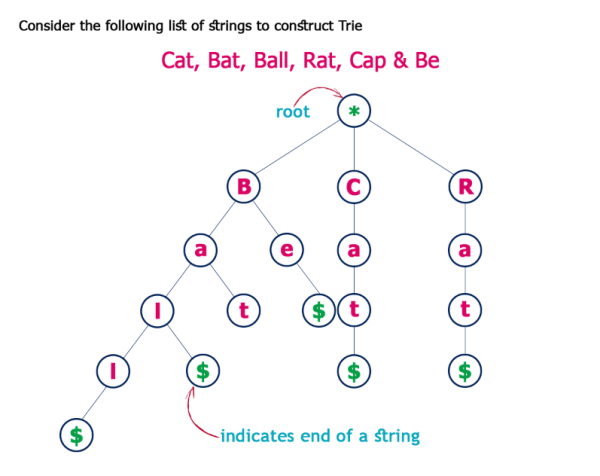
Trie也可以叫做Prefix Tree(前缀树),也是一种搜索树。Trie分步骤存储数据,树中的每个节点代表一个步骤,trie常用于存储单词以便快速查找,比如实现单词的自动完成功能。 Trie中的每个节点都包含一个单词的字母,跟着树的分支可以可以拼写出一个完整的单词,每个节点还包含一个布尔值表示该节点是否是单词的最后一个字母。
Trie一般有以下方法:
add:向字典树中增加一个单词
isWord:判断字典树中是否包含某个单词
print:返回字典树中的所有单词
/** * Trie的节点 */ function Node() { this.keys = new Map(); this.end = false; this.setEnd = function () { this.end = true; }; this.isEnd = function () { return this.end; } } function Trie() { this.root = new Node(); this.add = function (input, node = this.root) { if (input.length === 0) { node.setEnd(); return; } else if (!node.keys.has(input[0])) { node.keys.set(input[0], new Node()); return this.add(input.substr(1), node.keys.get(input[0])); } else { return this.add(input.substr(1), node.keys.get(input[0])); } } this.isWord = function (word) { let node = this.root; while (word.length > 1) { if (!node.keys.has(word[0])) { return false; } else { node = node.keys.get(word[0]); word = word.substr(1); } } return (node.keys.has(word) && node.keys.get(word).isEnd()) ? true : false; } this.print = function () { let words = new Array(); let search = function (node = this.root, string) { if (node.keys.size != 0) { for (let letter of node.keys.keys()) { search(node.keys.get(letter), string.concat(letter)); } if (node.isEnd()) { words.push(string); } } else { string.length > 0 ? words.push(string) : undefined; return; } }; search(this.root, new String()); return words.length > 0 ? words : null; } }8. Graph(图)

Graph是节点(或顶点)以及它们之间的连接(或边)的集合。Graph也可以称为Network(网络)。根据节点之间的连接是否有方向又可以分为Directed Graph(有向图)和Undrected Graph(无向图)。Graph在实际生活中有很多用途,比如:导航软件计算最佳路径,社交软件进行好友推荐等等。
Graph通常有两种表达方式:
Adjaceny List(邻接列表):
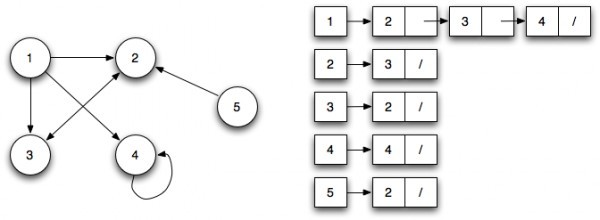
邻接列表可以表示为左侧是节点的列表,右侧列出它所连接的所有其他节点。
和 Adjacency Matrix(邻接矩阵):

邻接矩阵用矩阵来表示节点之间的连接关系,每行或者每列表示一个节点,行和列的交叉处的数字表示节点之间的关系:0表示没用连接,1表示有连接,大于1表示不同的权重。
访问Graph中的节点需要使用遍历算法,遍历算法又分为广度优先和深度优先,主要用于确定目标节点和根节点之间的距离,
在Javascript中,Graph可以用一个矩阵(二维数组)表示,广度优先搜索算法可以实现如下:
function bfs(graph, root) { var nodesLen = {}; for (var i = 0; i < graph.length; i++) { nodesLen[i] = Infinity; } nodesLen[root] = 0; var queue = [root]; var current; while (queue.length != 0) { current = queue.shift(); var curConnected = graph[current]; var neighborIdx = []; var idx = curConnected.indexOf(1); while (idx != -1) { neighborIdx.push(idx); idx = curConnected.indexOf(1, idx + 1); } for (var j = 0; j < neighborIdx.length; j++) { if (nodesLen[neighborIdx[j]] == Infinity) { nodesLen[neighborIdx[j]] = nodesLen[current] + 1; queue.push(neighborIdx[j]); } } } return nodesLen; }测试一下:
var graph = [ [0, 1, 1, 1, 0], [0, 0, 1, 0, 0], [1, 1, 0, 0, 0], [0, 0, 0, 1, 0], [0, 1, 0, 0, 0] ]; console.log(bfs(graph, 1));
打印:
{ 0: 2, 1: 0, 2: 1, 3: 3, 4: Infinity }感谢各位的阅读,以上就是“Javascript常见数据结构的实现方法是什么”的内容了,经过本文的学习后,相信大家对Javascript常见数据结构的实现方法是什么这一问题有了更深刻的体会,具体使用情况还需要大家实践验证。这里是亿速云,小编将为大家推送更多相关知识点的文章,欢迎关注!
免责声明:本站发布的内容(图片、视频和文字)以原创、转载和分享为主,文章观点不代表本网站立场,如果涉及侵权请联系站长邮箱:is@yisu.com进行举报,并提供相关证据,一经查实,将立刻删除涉嫌侵权内容。